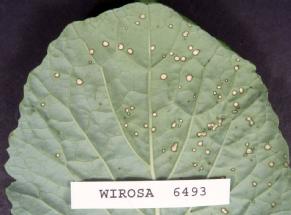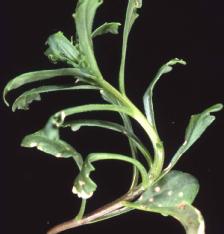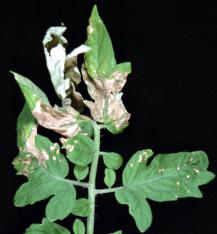Leaf spot disease of crucifers
The disease
Leaf spot diseases caused by Xanthomonas spp. have been reported to cause severe damage in a number of crops belonging to the Brassicaceae. Isolates of X. campestris that cause a leaf spot disease are sometimes obtained from commercial brassica seed. The host range is wide including most brassicas, ornamental crucifers, radish and tomato.
The symptoms of this non-vascular disease include leaf spots and dark sunken lesions on the middle vein, petiole and stem. Other pathovars of X. campestris including X. campestris pv. campestris, the cause of black rot, can produce leaf spots, but the host range of this disease is narrower and the symptoms are distinct.
This disease has usually been attributed to either X. campestris pv. armoraciae (McCulloch) Dye or X. campestris pv. raphani (White) Dye. We have proposed that the X. campestris isolates that cause a non-vascular leaf spot disease on Brassica spp. should be identified as pv. raphani and not pv. armoraciae (Vicente et al. 2006. Phytopathology. 96: 735-745).



Identification of races
Based on the differential reactions of several Brassica spp. and radish cultivars, the X. campestris pv. raphani isolates have been divided into three races and a gene-for-gene model has been proposed to explain the interactions (Vicente et al. 2006. Phytopathology. 96: 735-745).
Previous work at HRI / Warwick HRI
We have studied the pathogenicity and genetic diversity of X. campestris isolates that cause a leaf spot disease of brassicas and comparing these isolates with other pathovars of X. campestris (Vicente et al. 2006. Phytopathology. 96: 735-745).
Download handout of a poster presented at the BSPP Presidential meeting (Plant Pathology with a purpose), Nottingham 19-21 December 2005 and at the 11th International Conference on Plant Pathogenic Bacteria, Edinburgh, Scotland 11-14 July 2006.
Current work at the School of Life Sciences
We are currently working on the project 'Xanthomonas plant diseases: mitigating existing, emerging and future threats to UK agriculture', funded by UKRI, Defra and the Scottish Government, and part of the Bacterial Plant Diseases Programme. This project started in 2020 and is a collaboration between Warwick University, Fera Science Ltd and the University of Exeter.
We have studied the interactions between Arabidopsis thaliana and X. campestris pathovars including pv. raphani and pv. campestris (part of this work was included in Vania Horta de Passo's PhD, completed in October 2016/17). We have sequenced representative bacterial isolates and we have studied a plant disease resistance gene that confers resistance to some X. campestris pv. raphani isolates.
We reported the occurrence of X. campestris pv. raphani on wallflower in the UK for the first time (Stead et al. 2016. New Disease Reports, 34, 14). We are currently studying the diversity of X. campestris pv. raphani obtained from different hosts including brassicas, radish, ornamental crucifers and tomato.
For more information, please contact Joana G. Vicente.
